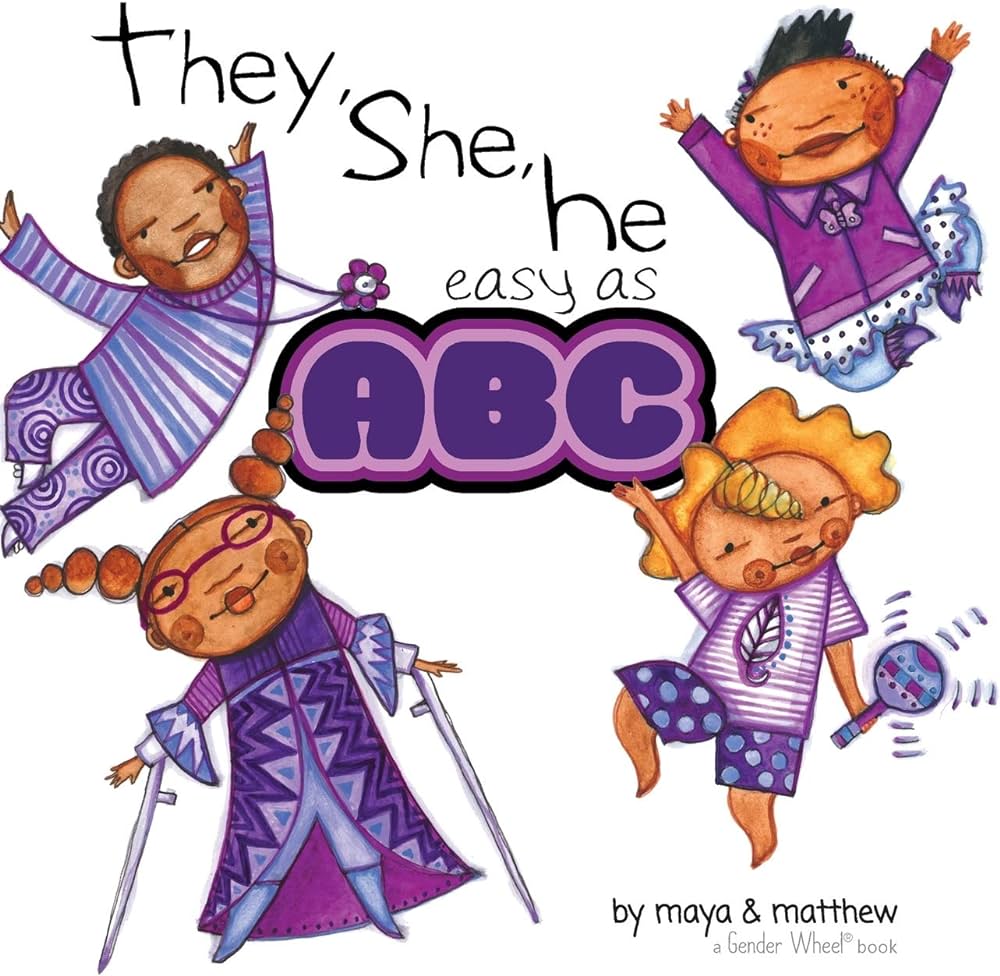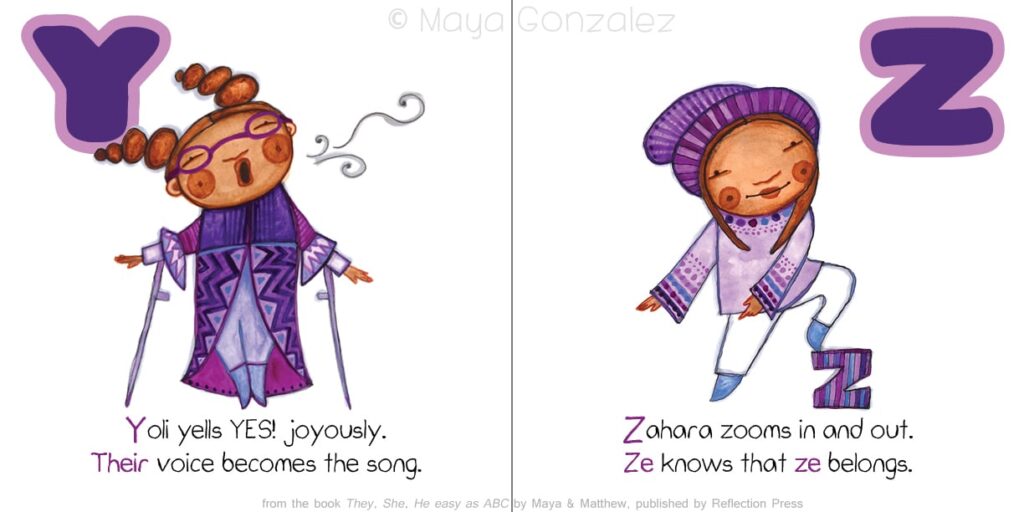
Inclusive Children's Book Teaching Guide
They, She, He: Easy as ABC
What is this book about?
In this joyously illustrated departure from classic ABC books, inclusive pronouns are introduced along with the letters of the alphabet.
The fast-paced, rhyming text models how to use a wide range of pronouns while the book's imagery dismantles gender stereotypes with hairstyles, wardrobe choices, and behaviors that are fresh and diverse.
Together, the rhymes and the artwork playfully expand ideas about gender while teaching young children that inclusion is as easy as A-B-C.
As the dance begins, the kids proclaim, “No one left out and everyone free,” in a singsong rhyme about inclusion. This sets the stage for readers to meet 26 kids showing off their dance moves.
This book continues the work started in They She He Me: Free to Be!, which the School Library Journal lauded as "a gorgeous and much-needed picture book about pronouns and gender fluidity."
Both books can be used to help build gender-inclusive practices and disrupt gender stereotypes and assumptions.
Who is depicted in this book?
- Diverse children who use a variety of pronouns
What early childhood themes and concepts does this book explore?
- Each letter of the alphabet is associated with the name of a child who expresses their unique identity through movement.
- Each child is depicted in a colorful illustration rendered in shades of lavender and purple.
- Diverse pronouns such as "they/them" and "ze," as well as children who use no pronouns or any pronoun
- Action words and the unique ways that each child dances and moves
- The joy of human diversity
How does this book support anti-bias education?
They, She, He: Easy as ABC features children expressing themselves through movement and dance while claiming the pronouns that fit them best. The story also introduces a variety of natural and engaging ways to use pronouns.
Depending on how the book is shared or used—and the developmental level of the children—They, She, He: Easy as ABC may be used to support the following core goals from Anti-Bias Education for Young Children and Ourselves:
Identity—Teachers will nurture each child’s construction of knowledgeable and confident personal and social identities so that children will demonstrate self-awareness, confidence, family pride, and positive social identities.
Diversity—Teachers will promote each child’s comfortable, empathetic interactions with people from diverse backgrounds so that children will express comfort and joy with human diversity, use accurate language for human differences, and form deep, caring connections across all dimensions of human diversity.
How can this book be used to meet early childhood learning standards?
For all ages
Use They, She, He: Easy as ABC to meet early childhood literacy standards
For children from birth to age three
Teaching suggestion: While sharing this book, model the characters’ movements and encourage the children to look at the book, watch you, and imitate your actions through back-and-forth exchanges.
What Illinois Early Learning Guideline does this meet for children from birth to age three?
Developmental DomainSocial-Emotional Development
Standard: Attachment RelationshipsChildren form secure attachment relationships with caregivers who are emotionally available, responsive, and consistent in meeting their needs.
Indicators for children:
- Uses social referencing with caregiver (7–18 months)
- Initiates and maintains interactions with caregivers (7–18 months)
- Initiates activities that are meaningful to the relationship, e.g., reading a favorite book together (21–36 months)
Teaching suggestion: Encourage the children to note the physical attributes, clothing choices, and other features of the book's characters and compare them to their own by making comments such as: "You're wearing stripes just like they are!"
What Illinois Early Learning Guideline does this meet for children from birth to age three?
Developmental DomainSocial-Emotional Development
Standard: Self-ConceptChildren develop identity of self.
Indicators for children:
- Displays beginning of joint attention (Birth–9 months)
- Engages in joint attention with familiar others (7–18 months)
- Points to self in images and other types of media (16–24 months)
- Begins to show interest in describing physical characteristics (21–36 months)
Teaching suggestion: Pick a letter. Find that letter in the book with the children and describe and imitate the movement modeled by the character on that page as you model the character's pronoun.
What Illinois Early Learning Guideline does this meet for children from birth to age three?
Developmental DomainLanguage Development, Communication and Literacy
Standard: Early LiteracyChildren demonstrate interest in and comprehension of printed materials.
Indicators for children:
- Children demonstrate interest in and comprehension of printed materials (Birth–9 months)
- Points to pictures in a book and reacts (7–18 months)
- Imitates gestures and sounds during activities, e.g., hand actions during singing, babbles as caregiver reads book (7–18 months)
- Points to familiar pictures and actions in books (16–24 months)
For preschoolers (ages three to five)
Teaching suggestion: Identify the letters of the alphabet while exploring the book.
What Illinois Early Learning and Development Standards does this meet for preschoolers?
Language Arts Standard4BDemonstrate an emerging knowledge and understanding of the alphabet.
Benchmark 4.B.ECa:
With teacher assistance, recite the alphabet.
Benchmark 4.B.ECb:
Recognize and name some upper/lowercase letters of the alphabet, especially those in own name.
Teaching suggestion: Select and share examples of ways that the characters in the book are similar and different. Point out differences that the children might not otherwise notice.
What Illinois Early Learning and Development Standards does this meet for preschoolers?
Social Studies Standard18AExplore people, their similarities and their differences.
Benchmark 18.A.ECa:
Recognize similarities and differences in people.
Teaching Suggestion: Ask the children to pick a letter and find its corresponding page in the book. Together with the children, describe and imitate the movement modeled by the child on that page. Model each child’s pronoun as you do so.
What Illinois Early Learning and Development Standards does this meet for preschoolers?
Language Arts Standard4BDemonstrate an emerging knowledge and understanding of the alphabet.
Benchmark 4.B.ECb:
Recognize and name some upper/lowercase letters of the alphabet, especially those in own name.
The Arts Standard25AInvestigate, begin to appreciate, and participate in the arts.
Benchmark 25.A.ECa:
Movement and Dance: Build awareness of, explore, and participate in dance and creative movement activities.
Teaching suggestion: Describe some of the similarities and differences between the children featured in the book and the children in the classroom. Encourage the children to notice and describe some of these similarities and differences.
What Illinois Early Learning and Development Standards does this meet for preschoolers?
Language Arts Standard1CUse language to convey information and ideas.
Benchmark 1.C.ECa:
Describe familiar people, places, things, and events and, with teacher assistance, provide additional detail.
Teaching suggestion: Encourage the children to share their own pronouns. Begin by modeling your own. This is a useful opportunity to introduce pronouns and convey the message that people tell us about their gender identities and pronouns.
What Illinois Early Learning and Development Standards does this meet for preschoolers?
Language Arts Standard2DEstablish personal connections with books.
Benchmark 2.D.ECa:
With teacher assistance, discuss illustrations in books and make personal connections to the pictures and story.
Social Studies Standard18AExplore people, their similarities and their differences.
Benchmark 18.A.ECa:
Recognize similarities and differences in people.
See inside this book.

